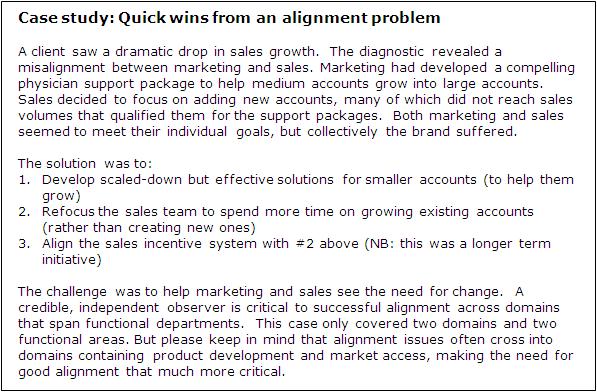World-class marketing performance: achieving smart profit growth from marketing excellence programs

Nick Keppeler
Simon-Kucher &, Partners
How do you get your marketing performance from good to world class? This article outlines a structure to help you prioritize your options, diagnose your biggest growth areas and define solutions.
How much would you wager that you have the right answers to these questions for your key brands?
1. What concrete actions should you take now or medium term to maximize financial performance?
2. How do you prioritize them?
3. Where should you pursue them?
Did you wager at least $50 million?
The manager of a blockbuster product typically would. That sum represents a 5% net improvement for a product with sales of $1 billion. If you answer those three questions using a marketing excellence program, 5%-10% would be a realistic return.
Defining marketing excellence
Consider a sales rep about to call on a physician. A number of critical marketing domains need to work together to make this call as effective as possible. Please consider these five:
• Target prioritization: Is the sales rep calling on the “right” physician?
• Value story: Does the rep have a compelling message?
• Segmentation: Is the message tailored to the needs of that physician?
• Clinical value creation: Is the message supported by sufficient evidence?
• Payer strategy and pull through: To what degree should market access be incorporated into the message?
Please note: To achieve marketing excellence, most products need to address 12-15 domains. To keep this article simple, yet illustrative, we will focus just on these five.
 ,
"The best marketing excellence initiatives start with an internal diagnostic."
 ,
World-class marketing performance means that you have a) aligned these domains, b) defined the right strategy and tactics for each domain to achieve your strategic objectives, c) empowered your field team and d) answered those questions sufficiently for a sales rep in the US, Germany, Brazil, Japan and any other critical market.
How you prioritize options
Even in our simplified example, a brand team could pursue any number of paths to a solution. Success depends on their ability to define hypotheses and set priorities. Evaluation criteria vary by company, but we typically recommend using some combination of these:
• Share / Revenue effect: How will that solution influence performance?
• Feasibility: How much effort will it take to execute?
• Timing: How long will it take complete and / or implement?
• Cost: What is the investment required?
• ROI: Will the expected return justify this solution over another?
How you diagnose the problem
The best marketing excellence initiatives start with an internal diagnostic. The goal is to generate hypotheses on the most promising areas to pursue, then generate solution concepts that you might want to validate with customers. You may also identify quick wins – especially for alignment across domains (please see the case study below). The typical diagnostic includes:
1. Internal interviews to ensure you have clearly and consistently articulated your intended marketing strategies and tactics to core functional groups.
2. Internal assessment of your product’s current market position.
3. Systematic review of your existing market data to see how consistent it is with the intended strategy articulated in #1.
 ,
"You may also identify quick wins – especially for alignment across domains."
 ,
4. Quick assessment of potential solutions to identify clear “knock-out” criteria (e.g. feasibility, cost and / or timeline).
A customer validation phase typically follows the internal diagnostic. That phase would have two major objectives: first, confirm hypotheses and quantify the effect they may have on your brand, second, test the effects of some concrete solution ideas. For example, you may want to understand the relative value of generating three different additional sets of data which you can use later to evaluate options per the prioritization framework defined above.
After this phase, you should have a workable number of solutions to prioritize.
How you define solutions toward marketing excellence
You have now defined several possible actions and have assessed the value they could contribute to your brand. You can now revisit the prioritization framework and add in feasibility, timing, cost, and expected ROI. This will help you prioritize the final list of options (and when to pursue them).
Most of the solutions you would pursue fall into one of three categories:
I. Alignment: Activities are viable from a silo perspective, but do not help the brand overall when you look across domains.
II. Strategy / tactics: The activities within a domain are not optimized to drive peak performance.
III. Execution: The systems to support implementation (goal definition, communication, training, measurement / KPIs, monitoring tools, or incentives) limit their effectiveness.
Once you have thoroughly worked through these steps, you should have a concrete set of high priority options to pursue. The value of pursuing those options is substantial – typically a 5-10% improvement in net sales. Your original wager at the start of this article revealed your confidence in knowing which actions to take. Now you need to ask whether you have achieved marketing excellence.
 ,
 ,
About the author:
Nick Keppeler, Partner, Simon-Kucher &, Partners.
Nick Keppeler specializes in helping clients attain peak financial performance from their brands by supporting their most critical strategic marketing challenges. He is a Partner in the Life Science division at Simon-Kucher &, Partners, Strategy and Marketing Consultants. Nick can be reached at +1 617-231-4500 or nicholas.keppeler@simon-kucher.com.
About Simon-Kucher &, Partners:
Simon-Kucher &, Partners is a global consulting firm with 650 professionals in 25 offices worldwide focusing on Smart Profit GrowthSM. Founded in 1985, the company has over 25 years of experience providing strategy and marketing consulting, and is regarded as the world’s leading pricing advisor.
How does your company define marketing excellence?













